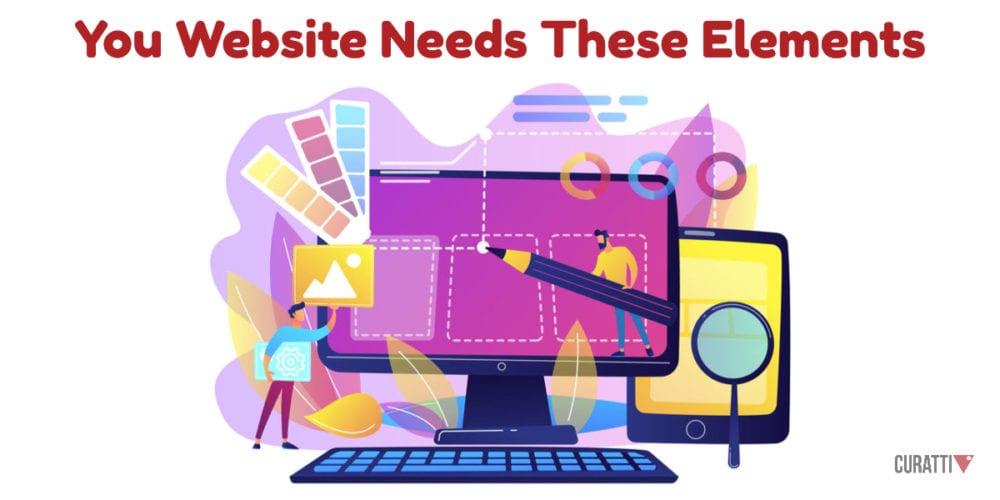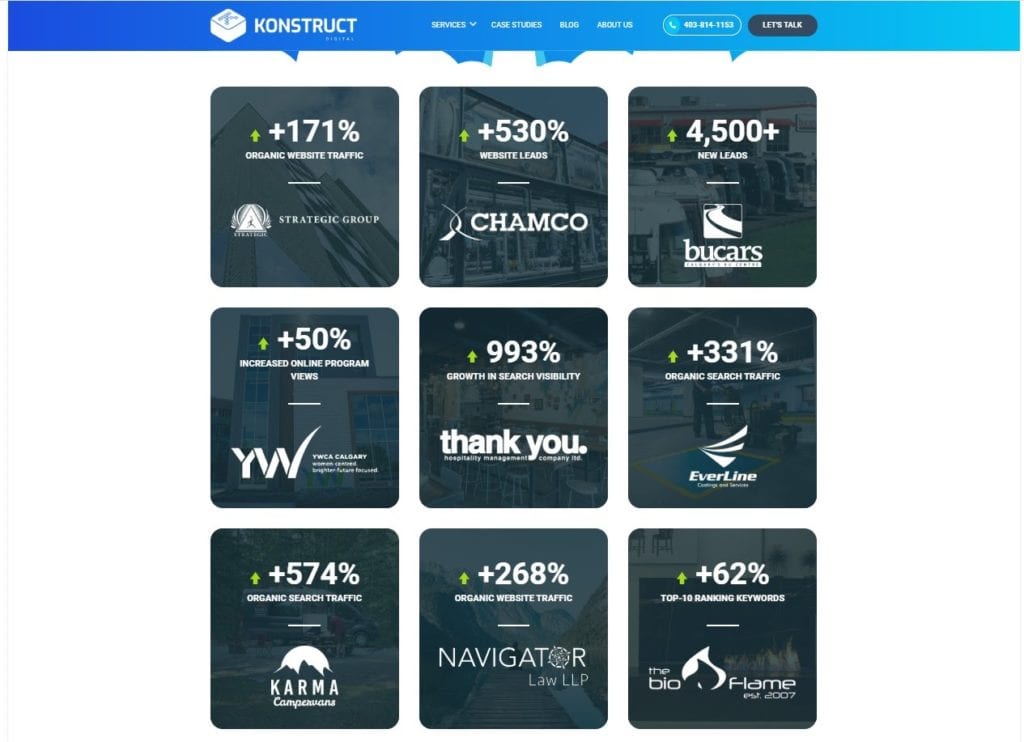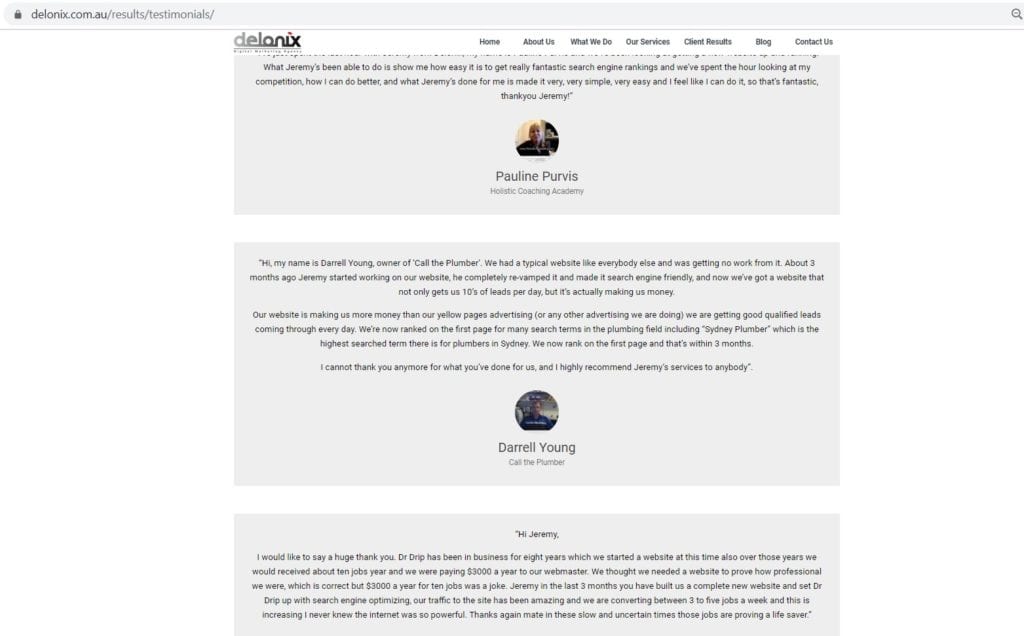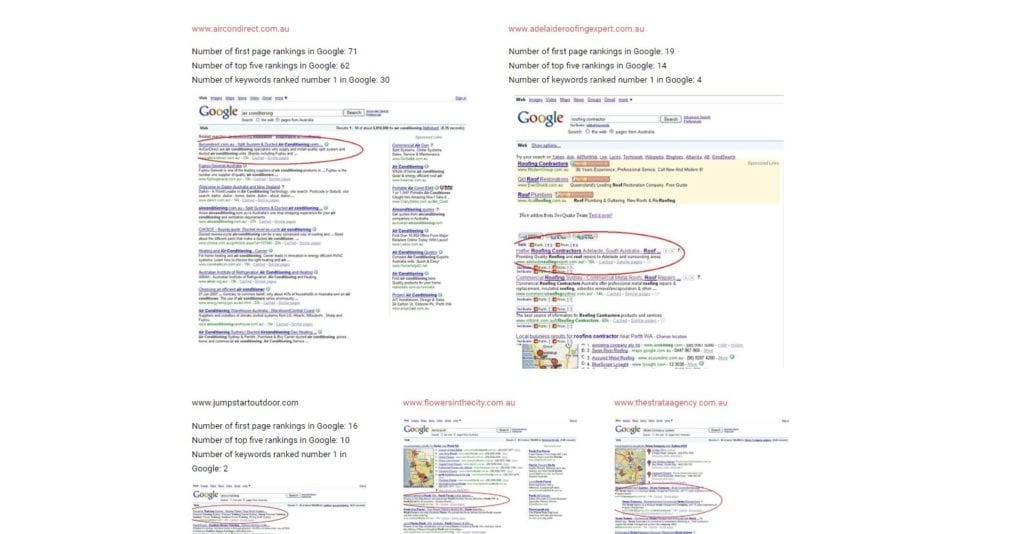5 Elements Your Agency Website Must Have

Trying to make your agency stand out from the crowd is incredibly hard. As your website is often the first impression potential clients will have, it’s worth the investment of time and money to make sure it’s up to scratch. Competition is increasing (both from other agencies, but also from internal departments and management consultancies as well).
This article explores 5 essential elements every agency website must have, to help you stand out from the crowd and make the most of your online presence.
Case Studies
Case studies offer a form of social proof and help build credibility. Therefore, they should definitely be included in your agency website.
If your agency is new and you don’t have any clients yet to provide a case study, try and offer your services at a heavily discounted (or free) rate to tempt clients to try you. In return, you can get a case study and use this to get fully paying clients.
Social Proof
Social proof is a phenomenon that has been around for a while, and if you are unsure what it is or why it is so powerful, I will outline that for you now. Then we will discuss why you should use case studies on your agency website.
Say, for example, you are walking down the road on a Friday afternoon looking for a restaurant. There are three next to each, and the two on the sides have no one in them. The one in the middle is extremely busy with groups of people laughing, talking, and having a good time.
Which restaurant would you choose?
Most people would say the middle one. You don’t know just looking from the outside which serves the better food, who has the best price, and how previous clientele have thought of their visit. This is the crux of social proof – people want to do what other people do.
This phenomenon is built deep within our evolutionary history. Think back to when homo sapiens had no iPhones, Netflix, or skinny low-fat vanilla frappuccinos and we were hunter-gatherers. We led a simple life off the land like the rest of the animal kingdom.
Safety In Numbers
If you were unsure how to act in a certain situation, you know you would likely be safe if you followed what everyone else was doing. Have you seen a specific wild animal for the first time and notice the rest of your group runs away quickly – you should probably run away quickly.
If you notice that everyone else in your tribe avoids eating a certain plant, you’d do well to avoid eating that plant. Doing what others do makes us feel at ease and comfortable, and therefore more likely to do something (even if that thing is categorically wrong, as the 1951 Solomon Asch Conformity Experiment demonstrates).
So we have seen why the power of social proof is so ingrained into us due to our past as hunter-gatherers. This is why it is one of the most potent marketing strategies.
Utilising Case Studies
Here’s a great example of how to utilise case studies by the SEO and Digital Marketing agency, Konstruct.
The reason this is a great example is that it’s simple and to the point. They have disclosed which client they were working with for each example, lending extra transparency and credibility. The statistics of how much each element improved is clear to see and easy to understand.
Potential clients who are looking at their website will see each and every service that they may be interested in purchasing, and importantly, Konstrukt have provided a case study for each service.
Due to the fact that it’ll help increase conversions by offering social proof, case studies are a necessity for every agency website.
Use Videos
There is no denying we are living in a world of multimedia elements and short attention spans.
If you scroll through your Facebook or Instagram right now, around 50% of the content you’d see would include videos (100 million hours of video are watched on Facebook daily). The second biggest search engine in the world is Youtube, a platform made primarily for videos.
There is no doubt that we, as a society, enjoy consuming information via videos. It comes naturally to us and keeps us engaged longer than reading can.
This is why they are incredibly powerful and used in marketing in every single industry across the globe. You too should include videos on your agency website. In fact, including videos on your websites could increase your revenue by up to 49%!
It’s been a long time since it has been expensive to plan, record, and edit one of these for yourselves. Almost everyone now has a 4k (or 1080p at the least!) video recorder in their pocket and there are a plethora of free and simple video editors. If you’re not very creative yourself or just don’t have the time, why not head to a freelance website such as Fiverr where you’ll find hundreds of people offering to do it for not a lot of money.
Often you’ll find videos that explain the services an agency offers. Others will combine this point with video testimonials and case studies, like the digital marketing agency Diving Bell Creative has done:
Video Placement
Try to ensure that you place videos in areas of your website that they will be seen. Diving Bell Creative had theirs on their homepage, ensuring most visitors will see it.
One thing for certain is that if you don’t have a video on your agency website, you are missing out to the ones that do.
Utilise Blogging
Blogging often gets overlooked nowadays, but it can still be the best, cheapest and easiest method of gaining lots of organic, relevant traffic to your website.
To highlight how important blogging is, here are a few key statistics:
Companies who blog receive 97% more links to their website.
I probably don’t need to stress the benefit of having so many more links to your site. At the end of the day, it means more traffic to your website and therefore more conversions and revenue.
SEO leads have a 14.6% close rate, while outbound leads have a 1.7% close rate.
Not only will your website receive more traffic, but the traffic that you do receive will close at a significantly higher rate. The reason for this is…
47% of buyers viewed 3-5 pieces of content before engaging with a sales rep.
Having a blog section on your website with multiple articles means there is a lot more content for people to engage with before making a purchasing decision, helping to build trust.
70-80% of users ignore paid SERP ads and only focus on organic results.
If your main strategy to win new business relies on paid ads, then you are missing out on the majority of your potential customers. Creating blogs is one of the only ways to reach these people, so therefore is crucial to the success of your website.
Ok, so I believe I have stressed the importance of blogging enough. But how does this look like on an agency website?
Here is a great example from the SEO agency, My SEO Sucks:
You’ll notice that the purpose of the blogs is to not overtly sell. Instead, they are there to pull in new traffic organically, and provide a sense of trust by positioning themselves as experts. They include an email sign up box to be notified about new blog posts. Once a user enters their email, it can also be used to send promotional and marketing material to convert the visitor into a client.
It is also split up into different categories, allowing you to filter the topics you are interested in. Alternatively, you can use the search bar to find more specific topics. These are both elements you will want to include in your own blog.
Customer Reviews
Customer reviews are similar to case studies but differ in one important aspect. Case studies come from the point of view of the company they promote (e.g. “We improved conversions by x%, we increased visitors by y%, etc.), whereas reviews are verbatim thoughts that customers had about their experience.
Reviews are coming from a place of emotion, whereas case studies come from an analytical place. Most people will take case studies with a pinch of salt – they know that this is the best-case scenario. Combined with the customer reviews, however, they become extremely powerful as they have a validating effect on one another.
Reviews are a crucial element of any commercial website. 72% of visitors will not take any action if they can’t see reviews. Whilst some people are sceptical of online reviews, only 6% say they don’t trust customer reviews at all. Therefore it is a much better decision to placate the 72% that need reviews to purchase your service vs the 6% who won’t trust them anyway.
Not only do reviews help directly with conversions, but they also help indirectly as they have a positive effect on SEO. (This is true only for reviews published on your site, also known as first-party reviews). Google sees these reviews as new user-generated content, and therefore it is likely it’ll have a good impact on your rankings.
It is estimated that you need 112 reviews to be seen as totally legitimate – so you better start curating those reviews sooner rather than later!
How To Utilize Your Customer Reviews
Here is an example of digital marketing agency Delonix utilizing customer reviews effectively:
This is a great example as they are direct quotes from customers (all are written in a different style so you know this is the case). Along with the review, they also include a photo, name, and company. This has the effect of adding further social proof, and making the reviews more credible and come across more authentic. They seem more like actual human beings who have used this service.
Delonix also adds some case studies to this page by providing screenshots of SERP results:
This is great for two reasons:
- It combines case studies with customer reviews.
- It doesn’t have fancy graphics, but provides a form of proof we all recognise. So it comes across as more transparent and authentic.
Not only do they combine case studies and customer reviews onto one page, but they also offer a video review:
This has the added bonus of all the things we mentioned above. Videos win, and this is a great example of how to use them in a natural way. Next to the video is a contact form, meaning that if the reviews do convert someone, they are less likely to get lost and give up whilst trying to find out how to get in touch.
Have a Clear Call To Action
For those who don’t know, a call to action (CTA) is essentially a prompt that is designed to cause an immediate action. It could be to “buy now”, “contact us”, or even “download our free white paper”. A call to action is how you, a webmaster, drives the user’s behaviour in a direction you want.
There have been many studies into how much of an impact having an effective CTA has on conversions. Here a few headline case studies:
One company increased their number of leads by 245% by making their CTA more convenient.
Their first CTA was to “Schedule a demo”. This is inconvenient, as users have to find a time they are free, hope the sales rep is free, and then sit through what would be, in all likelihood, a boring demo. They changed it to “Free 5 min demo video!”. They saw the huge increase in conversions as it is a lot more convenient for someone to download a video and watch in their own time than the alternative.
One company increased their number of paid leads by 148% by changing their CTA copy.
It makes sense that the words you use in your CTA have a big impact on how effective they are at having the result you desire.
Having a button that says “Click here” when you want someone to fill out a contact form may not do it. Instead, it should say “Get in touch!”, or something similar that explicitly says the action you want a user to take.
Little changes can make a big difference, so it’s a good idea to A/B test ideas until you find what works the best. In this example, they changed the CTA from “Click here!” to “Watch the demo video!”, which saw an increase in conversions of 148%. By changing the button again to “Watch the free video!” saw another increase of 9.49%.
Paying attention to your CTA pays off in a big way.
Here’s an example of how marketing agency Ardent Growth use an effective CTA:
As you can see, it is very clear. They are offering a free consultation on how someone could get more website traffic. It’s relevant to the target audience of the website, is in a clear position on the page (around halfway down), and is clear in what it is asking you. As an added bonus, it promises value for free.
Conclusion
To summarise, these are just a few things to keep in mind if you are creating a website for your agency.
Case studies offer a form of social proof and demonstrate the impact and value you can bring to clients.
Videos tap into the multimedia world we are living in and can help you give information to a potential customer in a format they are comfortable and familiar with.
Blogs offer one of the most effective methods of demonstrating expertise and growing traffic and conversions organically and quickly.
Customer reviews provide more social proof and build credibility as they are verbatim the words of your clients. They also work really well when combining with case studies or videos.
Having a clear call to action dramatically increases conversions and ensures the hard work you are putting in to get traffic isn’t wasted.
If you keep these 5 elements in mind when creating a website for your agency, you’ll be well on the way to creating the perfect foundation to grow your business.
Sign Up For Our Mailing List
If you’d like to receive more in-depth articles, videos and Infographics in your inbox, please sign up below

Sign up for the newest articles from Curatti, delivered straight to your inbox
Featured image: Copyright: ‘https://www.123rf.com/profile_rastudio‘ / 123RF Stock Photo
Shaurya Jain
Latest posts by Shaurya Jain (see all)
- 5 Elements Your Agency Website Must Have - July 22, 2020
- 17 SEO Experts Share Their Best Content Optimization Hacks - April 8, 2020






